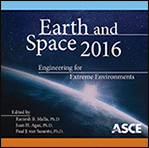15th Biennial ASCE Conference on Engineering, Science, Construction, and Operations in Challenging Environments
Detecting Loose Regolith in Lunar Craters Using Thermal Imaging
Publication: Earth and Space 2016: Engineering for Extreme Environments
ABSTRACT
Robotic missions could soon explore permanently shadowed craters on the lunar poles in order to characterize ice accumulation beneath the surface. However, the regolith in these craters is hypothesized to be very loose and could endanger a rover mission. This work analyzes the ability of thermal imaging to detect hazardous, low-density regolith in shadowed regions on the lunar poles. A series of simulations was conducted to estimate the surface temperature of lunar regolith as a function of density in polar craters. A generalized lunar crater model was used, and thermal properties of regolith were taken from experiments on Apollo samples. Results showed that in most situations there is a difference in temperature between nominal and loose regolith samples. This effect is most consistent at night in the absence of solar radiation and generally causes temperature differences between 2 K and 3 K. Based on comparisons to the capabilities of the DIVINER lunar radiometer, it is likely that regolith density differences would be detectable by a rover-mounted instrument.
Get full access to this article
View all available purchase options and get full access to this chapter.
ACKNOWLEDGEMENTS
Portions of this research were carried out at the Jet Propulsion Laboratory, California Institute of Technology, under a contract with the National Aeronautics and Space Administration. This work was supported by the NASA Small Business Technology Transfer Program as well as a NASA Space Technology Research Fellowship.
REFERENCES
Aye, K.M. et al., 2014. Diviner Monitoring of Coldest Lunar Polar Regions. 45th Lunar and Planetary Science Conference, p.2893.
Bandfield, J.L. et al., 2011. Lunar surface rock abundance and regolith fines temperatures derived from LRO Diviner Radiometer data. Journal of Geophysical Research, 116, p.E00H02.
Bauch, K.E. et al., 2014. Estimation of lunar surface temperatures and thermophysical properties: test of a thermal model in preparation of the MERTIS experiment onboard BepiColombo. Planetary and Space Science, 101, pp.27–36.
Carrier, W., 1974. Apollo drill core depth relationships. Earth, Moon, and Planets, 10, pp.183–194.
Cherkasov, I.I. et al., 1968. Soil-Density Meter-Penetrometer of the Automatic Lunar Station Luna-13. Soviet Physics Doklady, 13, p.336.
Costes, N.C., Farmer, J.E. & George, E.B., 1972. Mobility Performance of the Lunar Roving Vehicle: Terrestrial Studies – Apollo 15 Results., (December), p.87.
Cremers, C.J., 1973. Thermophysical Properties of Apollo 12 Fines. Icarus, 18, pp.294–303.
Cunningham, C., Nesnas, I. & Whittaker, W., 2015. Terrain Traversability Prediction by Imaging Thermal Transients. In Proceedings of the International Conference on Robotics and Automation.
Fergason, R.L. et al., 2006. Physical properties of the Mars Exploration Rover landing sites as inferred from Mini-TES-derived thermal inertia. Journal of Geophysical Research E: Planets, 111(2), p.E02S21.
Fountain, J. & West, E., 1970. Thermal conductivity of particulate basalt as a function of density in simulated lunar and Martian environments. Journal of Geophysical Research, 75(20).
Fountain, J. & West, E., 1976. Thermal Diffusivity of Lunar Fines: Temperature and Particle Size Effects. Lunar and Planetary Science Conference.
Fujii, N. & Osako, M., 1973. Thermal diffusivity of lunar rocks under atmospheric and vacuum conditions. Earth and Planetary Science Letters, 18(4817), pp.65–71.
Gamsky, J.N. & Metzger, P.T., 2010. The Physical State of Lunar Soil in the Permanently Shadowed Craters on the Moon. In Earth and Space. pp. 14–17.
Heiken, G., Vaniman, D. & French, B.M., 1991. Lunar sourcebook: a user’s guide to the moon G. Heiken, D. Vaniman, & B. M. French, eds., CUP Archive.
Hemingway, B., 1973. Specific heats of lunar soils, basalt, and breccias from the Apollo 14, 15, and 16 landing sites, between 90 and 350 K. Lunar and Planetary Science Conference, 3, pp.2481–2487.
Kieffer, H.H., 2013. Thermal model for analysis of Mars infrared mapping. Journal of Geophysical Research E: Planets, 118(3), pp.451–470.
Kring, D., 2006. Lunar Mobility Review. In Lunar Exploration Initiative.
Li, W. et al., 2010. Trafficability analysis of lunar mare terrain by means of the discrete element method for wheeled rover locomotion. Journal of Terramechanics, 47(3), pp.161–172.
Mitchell, D. L. & De Pater, I., 1994. Microwave Imaging of Mercury’s Thermal Emission at Wavelengths from .3 to 20.5 cm. Icarus, 110, pp.2–32.
Negi, B.S. et al., 1985. Solar limb darkening and ray trace evaluation of solar concentrators. Applied Optics, 24(2), p.296.
Okada, C. et al., 2009. A High-Resolution Structure of the Pre-microRNA Nuclear Export Machinery. Science, 326(5957), pp.1275–1279.
Paige, D. A. et al., 2010. The Lunar Reconnaissance Orbiter Diviner Lunar Radiometer Experiment. Space Science Reviews, 150(1-4), pp.125–160.
Paige, D. A. et al., 2010. Diviner Lunar Radiometer observations of cold traps in the Moon’s south polar region. Science (New York, N.Y.), 330(6003), pp.479–482.
Paige, D. A., Siegler, M. A. & Vasavada, A. R., 2010. Constraints on Lunar Heat Flow Rates from Diviner Lunar Radiometer Polar Observations. In American Geophysical Union, Fall Meeting 2010.
Taylor, G. et al., 2004. The Uncertain Nature of Polar Lunar Regolith. Space Resources Roundtable VI.
Vasavada, A.R. et al., 2012. Lunar equatorial surface temperatures and regolith properties from the Diviner Lunar Radiometer Experiment. Journal of Geophysical Research E: Planets, 117(4), pp.1–12.
Vasavada, A.R., Paige, D.A. & Wood, S.E., 1999. Near-Surface Temperatures on Mercury and the Moon and the Stability of Polar Ice Deposits 1., 193, pp.179–193.
Williams, J.G., Boggs, D.H. & Folkner, W.M., 2008. DE421 Lunar Orbit, Physical Liberations, and Surface Coordinates.
Information & Authors
Information
Published In
Earth and Space 2016: Engineering for Extreme Environments
Pages: 16 - 26
Editors: Ramesh B. Malla, Ph.D., University of Connecticut, Juan H. Agui, Ph.D., NASA Glenn Research Center, and Paul J. van Susante, Ph.D, Michigan Technological University
ISBN (Online): 978-0-7844-7997-1
Copyright
© 2016 American Society of Civil Engineers.
History
Published in print: Dec 30, 2016
Published online: Jun 29, 2017
Authors
Metrics & Citations
Metrics
Citations
Download citation
If you have the appropriate software installed, you can download article citation data to the citation manager of your choice. Simply select your manager software from the list below and click Download.
